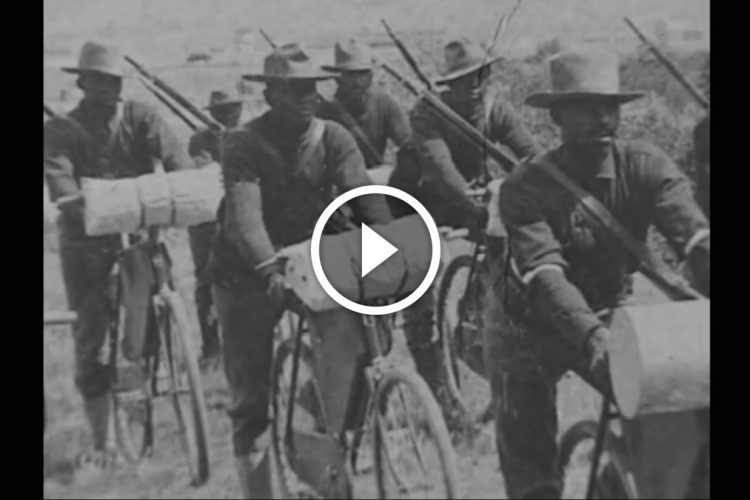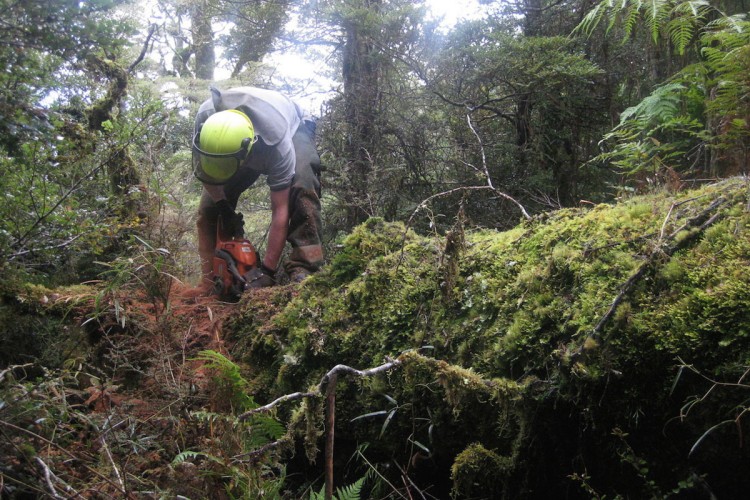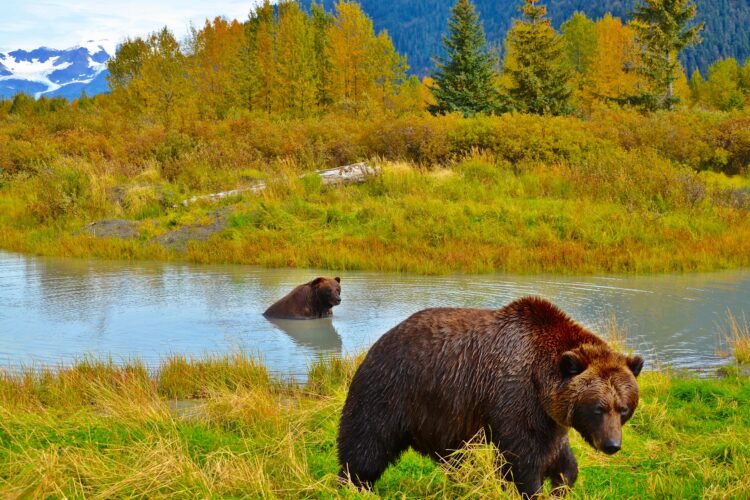Hopefully after reading the 10 Bikepacking Races to Put on Your Calendar article some of you may have felt a twinge of inspiration to head out on a bikepacking adventure. However, you may not yet know exactly how to embark on said adventure just yet. This article is meant for you, budding bikepacker.
[see_also id=’204267′]

In its simplest form, bikepacking is just a combination of two of the best things around–biking and camping–and there isn’t much need to complicate things further until you graduate to traveling longer distances, or racing in competitive events. I’d wager that the majority of the Singletracks readership have spent some time sleeping under the stars and therefore have a selection of camping equipment that can be used for bikepacking. The fun part comes when trying to figure out an elegant solution to bringing said gear with you when traveling by bike. Here’s a quick primer on getting yourself out in the middle of nowhere on your mountain bike.
The Bikepacking Bike
Don’t let your bike be an obstacle in your quest for bikepacking greatness. Odds are that the bike that you take out on to the trails day-in and day-out will be more than capable of going bikepacking. Personally, I like the simplicity and lower maintenance of a hardtail, as I figure that taking a rear suspension out of the equation lowers the potential failure points over the course of a bikepacking trip. However, having the extra capability and comfort of a full suspension setup could definitely make you a happier camper. In any case, before taking a hammer to the piggy bank and running out to the bike shop to get the newest bikepacking-specific, ultralight, gravel grinding, do-no-wrong wonderbike, give your current bike a chance.

[see_also id=’230222′]
Bikepacking Racks
The rack is the piece of equipment that really makes bikepacking possible and thankfully, with the bike touring market enjoying a massive increase in popularity, there are plenty of racks to choose from. While an in-depth comparison of all the options available to you is outside the scope of this primer, rest assured that there is definitely a rack that fits your budget and chosen bike.
If your bike has eyelets for racks, as many gravel grinders and touring bikes do, then your best bet is to find a rack setup that will bolt in directly. However, if you’re out adventuring on a mountain bike that wasn’t designed with touring in mind, odds are you’ll need to look for a system that uses clamps to attach to your chainstays and seatstays.
In addition to rear racks, you can also get a set of fork-mounted racks, should your fork allow. However, if you’re just planning on a weekend adventure, you most likely won’t need the extra storage. Like all things in the cycling world, the designs, materials, and prices of racks vary quite a bit, so it pays to do your due diligence when researching.
Some brands worth checking out are:
Bikepacking Panniers
Typically I’m not one to spend much time online looking at matching luggage sets or bags, but with bikepacking, it’s easy to get wrapped up in all of the choices and find yourself spending hours traveling down the bikepack rabbit hole. I was a bit of a fool when I bought my first pannier set and bought two bags that have no sort of internal organization at all, which led to many bouts of forced unpacking and associated cursing at 2am when trying to find batteries, snacks, tools, or whatever was needed at the time. Do yourself a favor and treat yourself to a good set of panniers that have lots of separated storage options. Speaking from experience, there are few things more frustrating than fishing through a pack, looking for a patch kit during a rainstorm, and pulling out your last pair of clean socks.
There are many companies to choose from, but here are a some of my favorites:

Bikepacking Framebags
For my past adventures, I’ve managed to stuff all of my gear into my two pannier bags, but now that I’m getting a little more serious about dialing in my kit, I’ve begun looking into bikepacking framebag options. As indicated by the name, a framebag is a bag that attaches to your bike’s frame directly, without any need for a rack, typically occupying the space between the main triangle of your bike, or attaching to the top tube or handlebars. They are typically used to augment your pannier set, but if you opt to go the ultralight route, you may be able to squeeze all you need for an extended tour into nothing more than a couple of framebags. Since I love to support the locals and because they make truly bomber equipment, I’m a big fan of Revelate Designs‘ bikepacking framebag choices.
Other options include:
The Bikepacking Repair Kit
Be sure to give your bike a thorough once-over before heading out and bring spares, because once you get out there, you’ll have to rely on yourself to keep things in working order on the trail. On my last bikepacking trip, I only needed one tube over the course of 630 miles. However, I’ve also blown through three tubes (one of which came by way of “trail magic”) on a 30-mile ride. In any case, err to the side of caution and remember the adage, “it’s better to have it and not need it, than need it and not have it.”
Plan on bringing:
- Two or more tubes (if not setup for tubeless)
- A patch kit
- Tire levers
- An inflation source (mini-pump or CO2)
- An extra chain link or SRAM Powerlink-esque link
- A Multitool (I use a Topeak Alien II and have only positive things to say)
- Chain lube (if you’re on an extended tour)
- Lights and batteries
- Bungees/Straps for affixing gear to your bike and/or MacGyver field repairs

[see_also id=’197940′]
The Bikepacker’s Campsite
At the end of a long day (or many long days) in the saddle, you’ll want to have a comfy place to rest and recover. Thankfully, this part is simple if you’ve camped before–just use the gear that you already own. Attach your sleeping pad and sleeping bag to the top of your rack, pack your tent into one of the panniers, and balance the load out by putting your camp kitchen equipment into the other. There’s really no trick to this part of the bikepacking prep work… until you try to start shaving weight from your setup. Then, you can substitute your tent for a bivy sack, pick up an ultralight sleeping bag, and switch your sleeping pad out for an inflatable pad to cut back on the grams.
Gear you’ll need for camping:
- Tent or tarp for shelter
- Sleeping Pad
- Sleeping Bag
Bikepacking Sustenance
When you’re covering a lot of ground by bike, you’re going to need a lot of fuel. That means that you get to indulge your inner fat kid and really start chowing down. The recommended caloric intake for males age 19 and up is about 2000 calories per day. You’re in for a treat if you’re bikepacking, though, because you get to shovel 3000+ calories into your facehole without the faintest pang of regret.
This means you’re going to need to either a) pack plenty of calorie-dense foods or b) plan on ordering extra fries when you stop off for lunch at the diner. Dehydrated food can be hit-or-miss, but brands like Backpacker’s Pantry have some pretty tasty options that have done well for me in the past.
If you prefer fresher food and don’t mind the extra space/weight penalty, preparing your meals in advance and packing them up is certainly an option. Make sure your foods are of the non-perishable variety, because the last thing you want is a frame bag turning into a petri dish.
When I’m in the saddle, I’m a fan of having a steady supply of Clif Bars and Pro Meal bars ready to keep a continuous stream of calories going to prevent the dreaded bonk. Also, plan on bringing plenty of water, as well as a way to filter or purify any water you may collect along the way.
Gear you’ll need:
- Kitchen stove (MSR Pocket Rocket, Jetboil, or smaller alcohol stove)
- Cookware
- Spork (Don’t leave home without one)
- Water purification solution (Chlorine solution, charcoal filters, gravity feed filtration)
- Food
The Bikepacker’s Plan
You didn’t just pack your panniers for fun (or maybe you did, if that’s your prerogative). All this prep work was for a reason–to go out on a journey by bike! Let your mind wander a while and think of some cool destination that you’d like to experience. Now, pull out the maps and find the twistier lines that you can string together to get to your destination. After you’ve drawn up your plans, you can choose the techy option and upload the route to your Garmin or smartphone, or you can go with the tried-and-true option of route notes on paper.
Finally–and most importantly–get out and ride!
[see_also id=’198154′]
Your turn: Have you tried bikepacking before? And if not, are you thinking about giving it a shot? Share your thoughts with us in the comments below!





















6 Comments
Jun 1, 2015
Jun 1, 2015
May 27, 2015
I've only completed a "bikepacking lite" trip where we spent a week riding between huts stocked with food, cooking supplies, and sleeping bags... and it was a blast! We only had to carry clothes and a sleeping bag liner (plus food and water for the day) so it was pretty simple.
For that trip, the tour operator suggested skipping panniers and going straight for a big hydration pack (or, in the case of my buddies, a medium size backpacking pack.) Their reasoning was that parts of the route would involve navigating singletrack and panniers could get snagged along the way.
I really try to avoid riding with any significant weight on my back so I went with a dry bag and a strap system from Revelate to cinch the bag to my bars. Worked great! I also brought a large Camelbak so I didn't end up needing panniers for this trip. Of course if I had a sleeping bag, tent, and cooking stuff it would have been a different story...
Jun 1, 2015
I'm in the midst of planning my gear packing for a big ride at the end of this month, it'll be interesting to see what I come up with; if I can fit a bivy, sleeping bag, and cooking stuff all in to framebags, then I should have a nice and compact setup for the event. If not, then I suppose I'll just be some yahoo getting his gear caught on trees haha
Dec 30, 2015
Jan 12, 2016